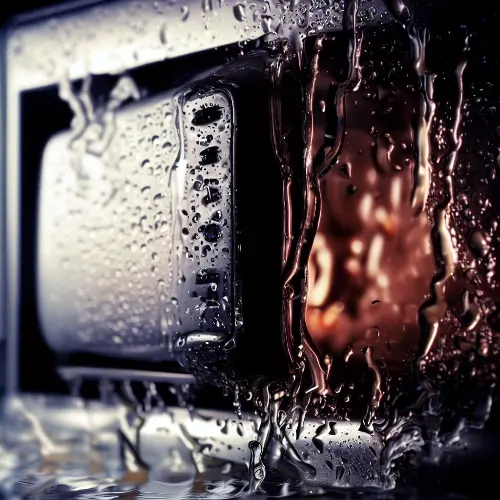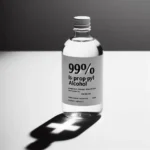Table of Contents
What Happens if a Microwave Gets Wet?
Microwaves are common kitchen appliances found in most homes. They provide a convenient way to quickly heat up or cook food. However, since microwaves contain electrical components, exposure to water or high moisture content can potentially damage the appliance.
So what exactly happens if your microwave gets wet? If your microwave gets wet, it can potentially damage the electronics and pose a safety risk, so it should be thoroughly dried and inspected before use. Here’s a closer look.
How Microwaves Work
To understand how water can damage a microwave, it’s helpful to first understand what’s inside the appliance. A microwave oven contains a magnetron, which generates microwaves that are directed into the interior cooking chamber.
The microwaves excite water molecules in the food, causing them to vibrate rapidly and produce heat. This allows the microwave to cook or heat up foods very quickly.
The magnetron and other internal components like the control panel, transformer, and capacitor are susceptible to water damage. That’s why it’s crucial to keep moisture away from these parts.
Water Can Get Inside in Various Ways
There are a few common ways that water can end up inside your microwave:
- Condensation – Microwaves produce steam when cooking, which can lead to condensation forming on the walls and ceiling. Some of this moisture may drip down onto the internal components.
- Spills – Accidentally spilling water or splashing liquids while cooking can cause water to seep into crevices and openings.
- Leaks – If the microwave is located below a cabinet, water leaks from above can drip down into the appliance.
- Rain – If your microwave is positioned near a window or outside wall, rainwater may enter through cracks or vents on the outer casing.
- Steam – Leaving the microwave door open while cooking allows steam to diffuse and condense on the control panel.
Dangers of Water Exposure
Why exactly is water so problematic for microwaves? There are a few potential issues it can cause:
- Short circuits – Water can conduct electricity. If it reaches any internal circuits or components, it can cause dangerous short circuits. This can trip breakers or blow fuses.
- Corrosion – Metallic parts like wires and contacts can start to corrode or rust when exposed to moisture over time. This can degrade microwave performance.
- Damage – Water getting into sensitive electronic parts like the magnetron can lead to complete failure or malfunction. This may require costly repairs or replacement.
- Electric shock – Exposed water anywhere in the microwave poses an electric shock hazard, especially if touching internal components.
- Fires – In severe cases, water damage can cause electrical shorts and arcing that could result in a fire hazard.
What to Do if Your Microwave Gets Wet
If your microwave does happen to get wet, here are some tips on what to do:
- Unplug it immediately – This will cut power to prevent short circuits or electric shocks. Don’t take risks by leaving it plugged in.
- Open the door to allow ventilation and drying. Leaving the door closed traps moisture inside.
- Soak up water from the interior with towels or cloths. Remove any standing water if possible.
- Leave the door open and allow the microwave to completely air dry over 2-3 days before using again.
- Do not turn it on until you are certain no moisture remains inside. Test it first with nothing inside.
- Clean surfaces with a dry soft cloth to absorb remaining droplets or condensation.
- Check for damage – Signs may include an inoperable display, unusual sounds, sparks, etc. Do not use a damaged microwave.
- If uncertain, have it serviced by a professional before attempting further use. Safety should be the top priority.
Preventing Water Exposure
The best way to protect your microwave from rain is to keep it away from windows or properly seal any openings. Here are some good prevention tips:
Position the microwave away from sinks or leaks. Have it installed in a dry location.
- Keep vents clear so that steam and moisture can properly ventilate.
- Leave the door open for a few minutes after cooking to allow steam to clear.
- Wipe up spills immediately and do not overfill containers that may splash.
- Ensure the outer casing does not have any cracks that could let in rain or water.
- Keep appliances in good repair to prevent leaks from oozing down into a microwave.
Is a Microwave Damaged by Rain Safe to Use?
If your microwave did get exposed to rainwater, it may or may not be safe to continue using afterward. Here are some factors to consider:
- How much water got inside? Brief light exposure may do no harm. Extensive soaking is more concerning.
- Did water appear to reach any internal components? This raises the electrical risk.
- Does it power on correctly? Does anything appear or smell burnt?
- Are there any unusual sounds, sparks, or errors during operation?
- Does it heat foods adequately and evenly? Or is performance declining?
Ideally, have the microwave professionally inspected and tested if heavy rain exposure is suspected. Be extremely cautious using it yourself until you can verify its proper and safe functionality. If in doubt, it’s best to replace it entirely to be safe.
Inspecting and Drying Out Your Microwave
If your microwave has become wet, here are tips for inspecting it and drying it out:
- Unplug from power before inspecting or cleaning.
- Remove any water droplets, pools, or stains with a dry soft cloth.
- Carefully disassemble the outer casing to inspect the internal parts.
- Look for moisture or corrosion on components like the magnetron, and capacitor wires.
- Allow all parts to air dry for 2-3 days before reassembling.
- Aim a fan or dehumidifier hose inside the unit to speed up the drying process.
- You may need to use isopropyl alcohol and swabs to clean or dry delicate parts.
- Place the microwave outdoors in the sun to aid drying if needed.
- Do not attempt to turn it on until completely moisture-free inside and out.
Thorough drying is essential before considering using your microwave again after water exposure. Never hasten the process or cut corners when safety is at stake.
FAQ
Here are answers to some frequently asked questions about the impacts of water on microwave ovens:
Can you put a microwave in the rain?
No, you should never leave or put a microwave in the rain or expose it to rainwater. The water can easily damage internal components and make the appliance unsafe to operate. Always keep it in a dry indoor location.
Is it OK if water boils over in my microwave?
No, you should promptly wipe up any boilovers or spills in your microwave’s interior. The boiling water produces steam which can then condense and cause problems. Avoid overfilling containers.
What if steam builds up in my microwave when cooking?
It’s normal for some steam to occur when cooking in a microwave. But leaving the door shut traps the steam inside, which can then condense on the electronics. Crack the door open to ventilate.
Can I microwave damp foods or plates?
It’s best to avoid putting damp items in the microwave as the evaporating moisture can damage it over time. Make sure foods and containers are dry before heating.
How do I dry out a microwave that got wet?
Unplug it, wipe excess moisture with towels, and leave the door open for 2-3 days. You may need to disassemble parts to ensure they dry fully before using them again. Never turn on a wet microwave.
Conclusion
Microwaves and water do not mix well. Exposure to rain, spills, condensation, or leaks can lead to dangerous electrical issues and damage to the internal components.
If your microwave does get wet, promptly unplug it, thoroughly dry out all areas, and have it professionally inspected before attempting further use. With proper care and precaution, you can help prevent moisture-related microwave disasters.

I’m Ian Welkins, a seasoned professional in the kitchen industry. My passion now drives me to provide invaluable insights into the world of top-notch kitchen products. With years of hands-on experience, I’m your go-to source for culinary excellence.











